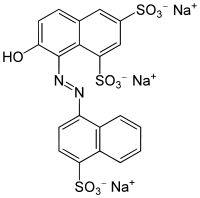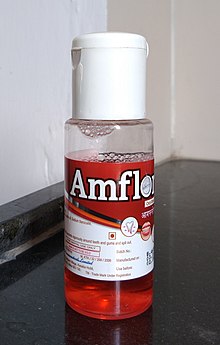Ponceau 4R
Ponceau 4R (known by more than 100 synonyms,[1]:460–461 including as C.I. 16255,[2] Cochineal Red A,[2] C.I. Acid Red 18,[2] Brilliant Scarlet 3R,[2] Brilliant Scarlet 4R,[2] New Coccine,[1]:460 is a synthetic colourant that may be used as a food colouring. It is denoted by E Number E124.[2] Its chemical name is 1-(4-sulfo-1-napthylazo)-2-napthol-6,8-disulfonic acid, trisodium salt. Ponceau (17th century French for "poppy-coloured") is the generic name for a family of azo dyes.
 | |
| Names | |
|---|---|
| IUPAC name
Trisodium (8Z)-7-oxo-8-[(4-sulfonatonaphthalen-1-yl)hydrazinylidene]naphthalene-1,3-disulfonate | |
| Identifiers | |
3D model (JSmol) |
|
| ChemSpider | |
| ECHA InfoCard | 100.018.216 |
| E number | E124 (colours) |
PubChem CID |
|
| UNII | |
CompTox Dashboard (EPA) |
|
| |
| |
| Properties | |
| C20H11N2Na3O10S3 | |
| Molar mass | 604.46 g·mol−1 |
| Hazards | |
| NFPA 704 (fire diamond) | |
Except where otherwise noted, data are given for materials in their standard state (at 25 °C [77 °F], 100 kPa). | |
| Infobox references | |
Ponceau 4R is a strawberry red azo dye which can be used in a variety of food products, and is usually synthesized from aromatic hydrocarbons; it is stable to light, heat, and acid but fades in the presence of ascorbic acid.[1]:460
It is used in Europe, Asia and Australia, but has not been approved for human consumption by the United States Food and Drug Administration.[1]:460[2]

Health effects
There is no evidence of carcinogenicity, genotoxicity, neurotoxicity, or reproductive and developmental toxicity at the permitted dietary exposures; the European acceptable daily intake (ADI) is 0.7 mg/kg and the WHO/FAO ADI is 4 mg/kg.[1]:460
The production process may result in unsulfonated aromatic amines present in concentrations of up to 100 mg/kg which may be linked to cancer. The lake pigment form of the colour additive can also increase the intake of aluminium beyond the tolerable weekly intake (TWI) of 1 mg/kg/week. Therefore, the limit for aluminium may be adjusted to accommodate for this.[3]
Possible cause of hyperactivity
Since the 1970s and the well-publicized advocacy of Benjamin Feingold, there has been public concern that food colourings may cause ADHD-like behavior in children.[4] These concerns have led the FDA and other food safety authorities to regularly review the scientific literature, and led the UK FSA to commission a study by researchers at Southampton University of the effect of a mixture of six food dyes (Tartrazine, Allura Red AC, Ponceau 4R, Quinoline Yellow WS, Sunset Yellow and Carmoisine (dubbed the "Southampton 6")) and sodium benzoate (a preservative) on children in the general population, who consumed them in beverages; the study published in 2007.[4][5] The study found "a possible link between the consumption of these artificial colours and a sodium benzoate preservative and increased hyperactivity" in the children;[4][5] the advisory committee to the FSA that evaluated the study also determined that because of study limitations, the results could not be extrapolated to the general population, and further testing was recommended".[4]
The European regulatory community, with a stronger emphasis on the precautionary principle, required labelling and temporarily reduced the acceptable daily intake (ADI) for the food colourings; the UK FSA called for voluntary withdrawal of the colourings by food manufacturers.[4][5] However, in 2009 the EFSA re-evaluated the data at hand and determined that "the available scientific evidence does not substantiate a link between the colour additives and behavioural effects".[3][4]
There is no evidence to support broad claims that food colouring causes food intolerance and ADHD-like behaviour in children.[6]:452 It is possible that certain food colouring may act as a trigger in those who are genetically predisposed, but the evidence is weak.[4][7]
References
- Abbey J, et at. Colorants. pp 459-465 in Encyclopedia of Food Safety, Vol 2: Hazards and Diseases. Eds, Motarjemi Y et al. Academic Press, 2013. ISBN 9780123786135
- FDA. 9 November 2008. Food and Drug Administration Compliance Program Guidance Manual, Chapter 03 - Foodborne Biological Hazards p37
- EFSA Panel on Food Additives and Nutrient Sources added to Food (ANS) 091113 efsa.europa.eu Scientific Opinion on the re-evaluation of Ponceau 4R (E 124) as a food additive EFSA Journal 2009; 7(11):1328
- FDA. Background Document for the Food Advisory Committee: Certified Color Additives in Food and Possible Association with Attention Deficit Hyperactivity Disorder in Children: March 30-31, 2011
- Sarah Chapman of Chapman Technologies on behalf of Food Standards Agency in Scotland. March 2011 [Guidelines on approaches to the replacement of Tartrazine, Allura Red, Ponceau 4R, Quinoline Yellow, Sunset Yellow and Carmoisine in food and beverages]
- Tomaska LD and Brooke-Taylor, S. Food Additives - General pp 449-454 in Encyclopedia of Food Safety, Vol 2: Hazards and Diseases. Eds, Motarjemi Y et al. Academic Press, 2013. ISBN 9780123786135
- Millichap JG, Yee MM (February 2012). "The diet factor in attention-deficit/hyperactivity disorder". Pediatrics. 129 (2): 330–337. doi:10.1542/peds.2011-2199. PMID 22232312.
